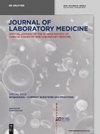RT-PCR detection of SARS-CoV-2 in nasopharyngeal and salivary specimens: contribution of alternative collection systems and extraction processes to cope with mass screening. Interpretation of low viral loads
IF 1.8
4区 医学
Q4 MEDICAL LABORATORY TECHNOLOGY
引用次数: 1
Abstract
Abstract Objectives Due to massive screening of the persistent coronavirus SARS-CoV-2, supply difficulties emerged for swabs and extraction reagents leading to test alternative choices. Quality sampling may have an impact on the result and a low RNA detection may be difficult to interpret because it does not necessarily mean that infectious particles are present in biological samples. There is a need to understand whether the Ct value information is relevant and informative. Methods We compared the pre-analytical stability of RNA in saline solution, UTM®, Amies and Cary-Blair transport media. Expression profile of E, N and RdRp genes was assessed at various concentration levels with the Allplex™ 2019-nCoV Assay. Factors that may influence the determination of Ct were studied with several extraction reagents coupled to the GSD NovaPrime® SARS-CoV-2 RT-PCR testing kit. Results Seventy two-hour RNA stability has been demonstrated for all the transport media assessed. A matrix effect was shown, leading to a decrease in the detection of E and RdRp genes, so that only N gene was often found for Ct greater than 35.0. A follow-up over more than 67,000 patients suggests that N gene may be a sensitive indicator to detect a new active viral circulation, but establishing a correlation between a positive threshold and a low risk of infection for a given method remains difficult. Conclusions Several transport media and extraction processes are suitable for PCR-based SARS-CoV-2 detection. During periods of active virus circulation, any weakly positive results should be considered.鼻咽和唾液标本中SARS-CoV-2的RT-PCR检测:替代采集系统和提取工艺对应对大规模筛查的贡献解释低病毒载量
摘要目的由于对持续性冠状病毒严重急性呼吸系统综合征冠状病毒2型的大规模筛查,出现了拭子和提取试剂的供应困难,导致了检测的替代选择。高质量的采样可能会对结果产生影响,低RNA检测可能很难解释,因为这并不一定意味着生物样本中存在传染性颗粒。需要了解Ct值信息是否具有相关性和信息性。方法我们比较了RNA在盐水溶液、UTM®、Amies和Cary-Blair转运介质中的分析前稳定性。用Allplex在不同浓度水平下评估E、N和RdRp基因的表达谱™ 2019-nCoV检测。使用与GSD NovaPrime®严重急性呼吸系统综合征冠状病毒2型RT-PCR检测试剂盒偶联的几种提取试剂研究了可能影响Ct测定的因素。结果所有评估的转运培养基的RNA稳定性均为72小时。显示出基质效应,导致E和RdRp基因的检测减少,因此Ct大于35.0时通常只发现N基因。对67000多名患者的随访表明,N基因可能是检测新的活跃病毒循环的敏感指标,但对于给定的方法,建立阳性阈值和低感染风险之间的相关性仍然很困难。结论几种转运介质和提取工艺适用于基于PCR的严重急性呼吸系统综合征冠状病毒2型检测。在病毒活跃循环期间,应考虑任何弱阳性结果。
本文章由计算机程序翻译,如有差异,请以英文原文为准。
求助全文
约1分钟内获得全文
求助全文
来源期刊

Journal of Laboratory Medicine
Mathematics-Discrete Mathematics and Combinatorics
CiteScore
2.50
自引率
0.00%
发文量
39
审稿时长
10 weeks
期刊介绍:
The Journal of Laboratory Medicine (JLM) is a bi-monthly published journal that reports on the latest developments in laboratory medicine. Particular focus is placed on the diagnostic aspects of the clinical laboratory, although technical, regulatory, and educational topics are equally covered. The Journal specializes in the publication of high-standard, competent and timely review articles on clinical, methodological and pathogenic aspects of modern laboratory diagnostics. These reviews are critically reviewed by expert reviewers and JLM’s Associate Editors who are specialists in the various subdisciplines of laboratory medicine. In addition, JLM publishes original research articles, case reports, point/counterpoint articles and letters to the editor, all of which are peer reviewed by at least two experts in the field.
 求助内容:
求助内容: 应助结果提醒方式:
应助结果提醒方式:


